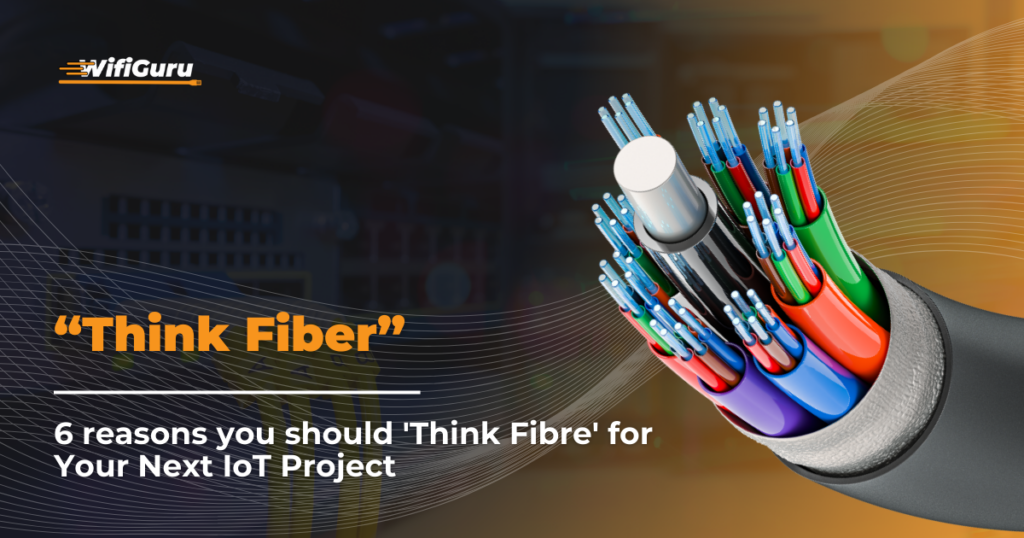
The Internet of Things (IoT) is transforming industries and daily life by connecting devices and enabling smarter, data-driven environments. Traditionally, IoT projects have relied on wireless and broadband connections to facilitate communication between devices. However, as IoT applications become more sophisticated and data-intensive, the limitations of these traditional connectivity methods become apparent. Enter fiber-optic internet—a solution that offers unparalleled speed, reliability, and scalability. Here are six compelling reasons to ‘think fiber’ for your next IoT project.
1. Unmatched Speed
Current Reliance: IoT systems have largely depended on wireless and broadband connections. While sufficient for many applications, these connections can suffer from limited bandwidth and slower speeds, especially in densely populated or heavily networked areas.
Why Switch to Fiber: Fiber-optic internet provides significantly higher speeds compared to traditional copper or DSL connections. This high-speed connectivity is crucial for IoT applications that require real-time data transmission and processing. For instance, in smart cities, traffic management systems must process and respond to data instantaneously to optimize traffic flow and reduce congestion. The high bandwidth of fiber-optic connections ensures these systems can operate efficiently without delay, enhancing overall performance and user experience.
2. Enhanced Reliability
Current Reliance: Wireless and broadband connections are prone to environmental factors such as electromagnetic interference, weather conditions, and physical obstructions, leading to signal degradation and interruptions.
Why Switch to Fiber: Fiber-optic cables are inherently resistant to many of these environmental interferences. They are less susceptible to electromagnetic interference and can withstand harsh weather conditions better than copper cables. This robustness translates to fewer downtimes and more consistent performance, making fiber the ideal choice for critical IoT applications like healthcare monitoring, industrial automation, and security systems. With fiber, you can trust that your IoT devices will remain connected and operational when you need them most.
3. Scalability
Current Reliance: Expanding IoT networks with traditional broadband can lead to bandwidth limitations and performance bottlenecks as more devices are added.
Why Switch to Fiber: Fiber-optic networks are inherently scalable, supporting massive increases in data throughput without compromising performance. This scalability is essential for future-proofing your IoT infrastructure, allowing you to add more devices and services seamlessly. Whether expanding a smart building’s sensor network or scaling up an industrial IoT system, fiber ensures your network can grow without hitting capacity limits. This scalability also means you can adopt new technologies and integrate more advanced IoT solutions without worrying about connectivity constraints.
4. Low Latency
Current Reliance: Wireless and broadband connections often experience higher latency, which can hinder the performance of time-sensitive IoT applications.
Why Switch to Fiber: Fiber-optic internet offers extremely low latency, which is crucial for applications requiring real-time communication and instant responses. For example, in autonomous vehicles and remote surgery, milliseconds can make a significant difference in outcomes. Low latency ensures that data is transmitted with minimal delay, enhancing the performance and safety of these critical applications. This capability is essential for any IoT project where timely data transmission is vital for operational efficiency and effectiveness.
5. Future-Proof Technology
Current Reliance: Traditional broadband technologies are approaching their performance limits and may require frequent upgrades to keep up with evolving IoT demands.
Why Switch to Fiber: Fiber-optic technology is designed to support future advancements in connectivity and data transmission. With the ongoing development of smart cities, industrial IoT, and advanced healthcare solutions, fiber-optic networks provide a long-term solution that can adapt to and support new technologies as they emerge, reducing the need for frequent infrastructure overhauls. By investing in fiber now, you’re not just meeting today’s needs but also ensuring your infrastructure is ready for tomorrow’s innovations.
6. Cost Efficiency in the Long Run
Current Reliance: While initial setup costs for wireless and broadband connections may be lower, ongoing maintenance and upgrades can add up over time, particularly as the network grows.
Why Switch to Fiber: Although the initial investment in fiber-optic infrastructure can be higher, the long-term benefits of reduced maintenance costs, fewer disruptions, and the ability to handle future data demands make it a cost-effective choice. The durability and reliability of fiber mean fewer repairs and replacements, saving money and resources in the long run. Additionally, the enhanced performance and efficiency of fiber can lead to cost savings in operational processes and improved productivity.
Conclusion
Switching to fiber-optic internet for your IoT projects ensures you are equipped with the speed, reliability, and scalability needed to support advanced applications and future growth. As IoT continues to evolve, the demand for robust connectivity will only increase. At Wifi Guru, we provide cutting-edge connectivity solutions to make your IoT projects successful and sustainable. Invest in fiber today to unlock the full potential of your IoT initiatives and stay ahead in the rapidly advancing digital landscape.
By choosing fiber, you’re not just upgrading your connectivity—you’re future-proofing your business, enhancing efficiency, and ensuring that your IoT projects can scale and adapt to meet the demands of tomorrow.